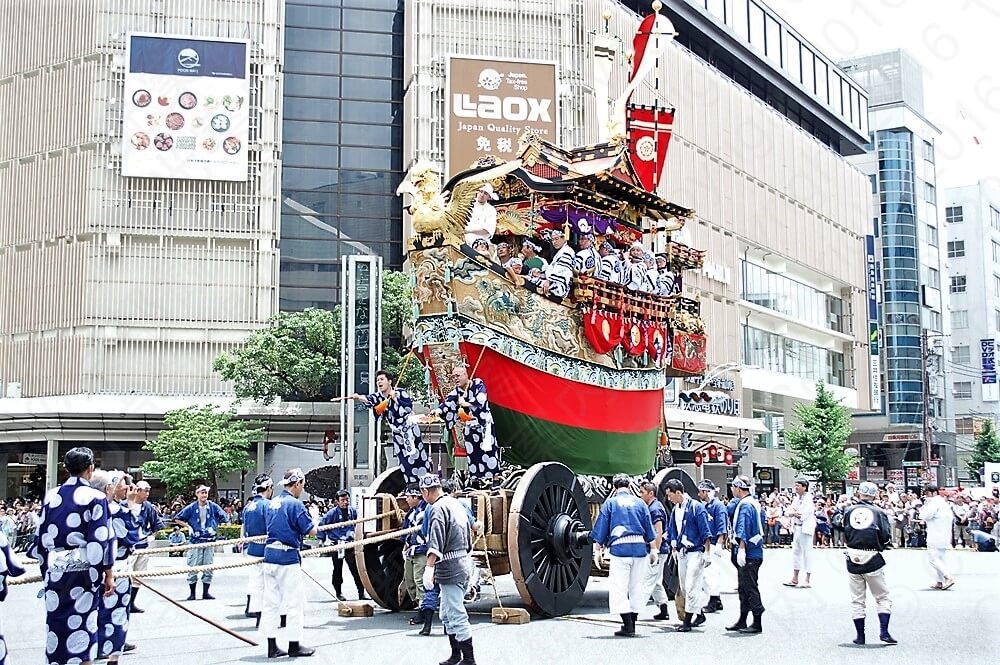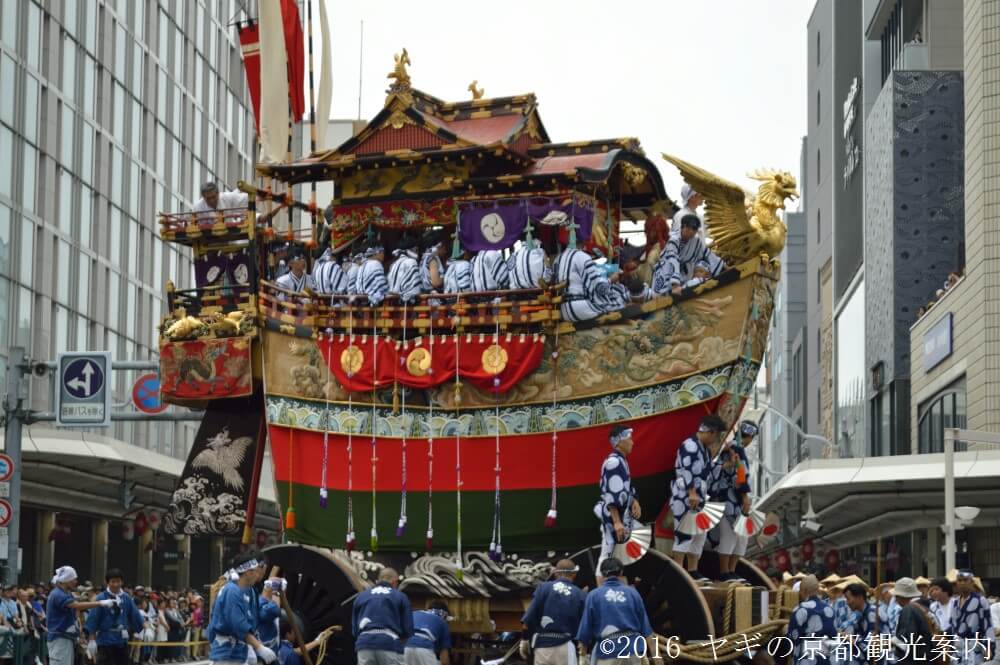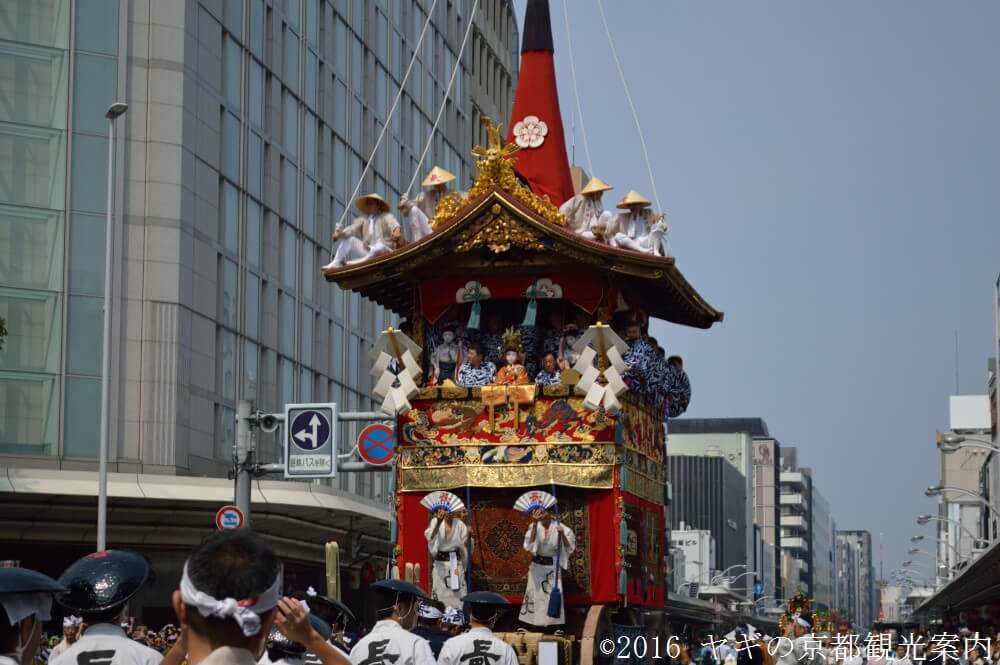Introduction
Gion Matsuri festival is famours for Yamahoko floats and their parade lures lots of people to the ancient capital in the heat of mid-summer.
Each Yamahoko belongs to small area called “Cho/Machi” in the downtown and play peculiar roles in the festival: To brighten up the festival and to have Ekijin/Ekishin descend to it.
The parade in which Yamahoko with these roles in Gion Matsuri festival started in the 14th century.
In this post, we learn about the roles of Yamahoko and the origin of Yamahoko floats.
What is Yamahoko float?
In the long history of Gion Matsuri, we can find a few things resemble what we call Yamahoko floats today but they have distinctive features to distinguish them from the others.
- Denizens of the downtown prepare them.
- They work as Yorishiro.
- They brighten up the festival.
Hoko in Gion Goryoe 祇園御霊会の矛
The word “Hoko” appears in the first Gion Goryoe, the former name of Gion Matsuri.
Gion Honsha Enroku (『祇園社本縁録』), a historical book on Yasaka shrine formerly known as Gion sha temple, describes: Japan suffered from epidemics and natural disasters in 869. A priest of Gion sha found the curse of Gozu Tenno caused them.
In Shinsenen, the private garden of Emperor, he prepared 66 Hoko(矛) which represented the states thorough the archipelagoand and Gion sha sent Mikoshis there for the purpose of getting rid of the curse.
This ritual is called Shinsenen Goryoe and is believed the beginning of Gion Matsuri.
“Hoko” in Yamahoko is written as 鉾 in Kanji.
矛 and 鉾 are pronounced the same but spelled different. 矛 is a name of arms. Ancient people believed that it is Yorishiro, an object deities descend to and it has sacred power to do away anything evil.
We can find this kind of Hoko even today.
For example, Kamo Kurabeuma, a ritual held prior to Aoi Matsuri festival, three Hoko are considered as the Deities of Kamigamo shrine.
And in Gion Matsuri, Hokos escort Mikoshis to keep evilness away from them.
Some believe that people developed the 矛 in Gion Goryoe into Yamahoko floats because they pronounced “Hoko” and Yamahoko floats work as Yorishiro. But they are totally different from Yamahoko floats: Hokos in Shinsenen Goryoe were prepared by Gion sha and a priest of it. On the other hand, the Hokos worked as Yorishiro because they represented the Ekijin of each state.
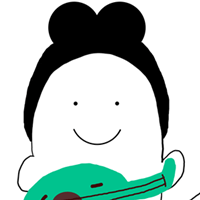
Basically, Hoko works as Yorishiro.
Tsukuriyama of Mukotsu Hoshi
Honcho Seiki (『本朝世紀』), a history book compiled in the 12th century, describes that a comedian called Mukotsu Hoshi visited Gion sha with Tsukuri Yama looked like Shimeyama in 999.
The Tsukuriyama resembles Hoko today in appearance and prepared by a comedian, not Gion sha or the Imperial Court. We can consider it as a prototype of Yamahoko in appearance and its function: To brighten up the festival.
As well as Tsukuriyama of Mukotsu Hoshi, we can find another prototype in Shyoyuki (小右記), a diary of an aristocrat written in the 10th and 11th century. It reports that Sangaku Munaguruma followed Mikoshi. Sangaku is a dance performance and Munaguruma is a kind of mobile stage with wheels.
These two prototypes resemble Yamahoko in appearance and in the function to brighten up the festival but differs in most important point of view: They don’t work as Yorishiro.

I think we can see them as primitive forms of Yamahoko in appearance and function.
Bajyo Hoko
In Gionshaki (『祇園社記』), a history book of Gionsha, we can find a chapter called “馬上御鉾次第事.” It is translated as “About Bajo Hokos.” Bajo Hoko means Hokos have something to do with Bajoyaku, or “Hokos on horseback.”
Bajoyaku is persons who covered the cost of the Matsuri. As described before, Gion Goryoe was held by the support of the Imperial court and aristocrats.
Around the 12th century, they were on financial decline and were not able to afford Gion Goryoe in every summer though they are in charge of preventing epidemics and natural disasters.
In the 12th century, Retired Emperor Goshirakawain chose merchants with wealth and asked them to pay the cost of Gion Goryoe.
If Bajo Hoko means Hokos which have something to do with Bajoyaku, they can be Hokos strolled with them, along with Mikoshis.
And if Bajo Hoko means Hokos on horseback, they are Hokos held by persons on their steed.
In both cases, the Hokos worked as Yorishiro but they are not the same thing as Yamahoko float today: They belonged to monks and their family, not to inhabitants of Kyoto.
Hoko of Za
Ancient shrines and temples had a persons called Jinin, or Yoriudo. They served for a shrine of temple they belonged, and the shrines and temples gave privileges to their business instead. The earliest Jinin of Gion sha were members of Za, a Japanese guild. Emperor Yozei donated the place where the Za located. The inhabitants of it automatically became Jinin of Gion sha.
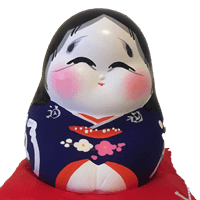
The emperor “donated” it because Jinin paid taxes to Gion sha, not to the Imperial Court. For the emperor, he donated the right to put tax on the land and Jinin.
They belonged the Za of lumber and they made a temporal bridge for Mikoshi of Goryoe every summer as their service for Gion sha.
In 12th century, Imperial Court put taxation on the businesses of the merchants of Kyoto. Following this, shrines and temples increased Za for the purpose of gaining income. They guaranteed many privileges and safeties for their businesses.

The Imperial Court’s tax revenue depended on the land its had. Around the 12th century, there were lots of manors in the archipelago and the tax revenue of The Imperial Court was on decline. So, they decided to put taxes on persons instead of land.
On the other hand, shrines and temples gained their income because they had lots of manors which the merchants lived in. They belonged to shrines and temples.
Showing their gratitude for Gion sha, they served Yamas and Hokos for Mikoshis of the Goryoe. Gion Sha Kiroku, (『祇園社記録』), a history book of Gionsha, tells that there happened a conflict among merchants of silk in the 14th century. Gion sha gave them a verdict saying, “To be a Za, it must serve for the festival of June (Gion Goryoe).”
This incident indicates that merchants were not able to form Za without serving Gion Goryoe in the area where Gion sha ruled.
Around the 14th century, Za started to loose its independence and the ties between merchants but the service for Gion Goryoe was saved because the bond as members of territorially-based community was left.
In 1369. Enryakuji temple was in need to renovate its Mikoshi but it was not able to afford of it. So Enryakuji didn’t have Mikoshi for around twenty years. Gion sha belonged to Enryakuji and Gion Goryoe carried on without Mikoshi for nearly two decades.

Gion sha with Mikoshi though Enryakuji was without Mikoshi. The idea was not acceptable at that time.
In this period, the denizens of the downtown developed Yamas and Hokos.
These facts leads the foundation of Yamahoko parade we know today; Denizens of the downtown prepare them to brighten up Gion Matsuri.
We cannot sure why Yamahoko plays a role of Yorishiro. I suppose the twenty decades mihgh give us an answer. Mikohsi paraded with Hokos worked as Yorishiro. Bajohoko is this kind of Hoko. Even today, Hokos of Shimpo Gyorestu lead Mikoshis of Gion matsuri.
The ancient people wanted a role of Mikoshi and Yorishiro-Hoko on Yamahoko floats.

